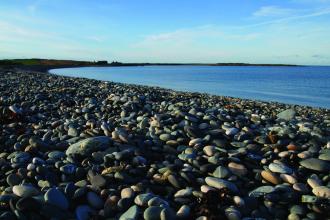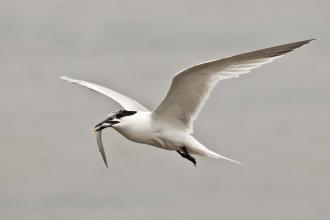The Cemlyn terns are now well on their way to their wintering grounds far south, this long journey and rare beauty inspire us in many ways. This includes the desire to do something to ensure they have somewhere to call their summer home. In the first of two blogs, part of the fiftieth anniversary of Cemlyn as a nature reserve, we take a look at some of the people who have been involved in the protection of the Cemlyn tern colony over this period.
Committees and caravans - their role in saving terns
A sunny day provides an opportunity to learn about the tern colony: Photo NWWT
The Wildlife Trust leased Cemlyn from the National Trust in 1971. A new reserve management committee had its first meeting, in July 1971. The Wildlife Trust was represented by the Executive Officer, Mr David Shaw, and volunteers Dr Eifion Jones, Mrs Jane Rees, local ornithologist Mr Tony Mercer, the National Trust agent Mr John Tetley, Mr Dennis Jones representing the Community Council, and Peter Hope Jones and Dr Stephen Ward, from the Nature Conservancy (NC) to provide ecological expertise. Peter Hope Jones wrote the first management Plan. Later on, trust volunteer Mr Michael Smith, Mr John Jones one of the NT’s tenant farmers and Mr David Hewett (NC) joined the committee. It was planned to cover not only management for the wildlife interest but also the interests of the local community and the NT farming tenants who might be affected by the Wildlife Trust’s activities. Jane Rees with support from her husband Ivor, acted as committee secretary for many years, regularly visiting the reserve to record the wildlife, organising working parties and for a while in the 1980s interviewing prospective summer reserve wardens.
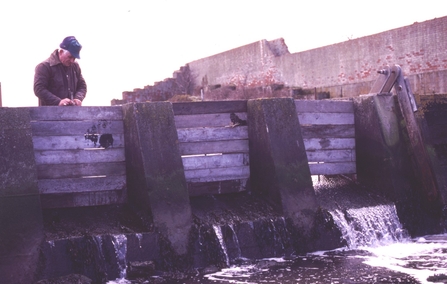
Mike Smith, at work on the Cemlyn weir in the early 1980s. Credit Jane Rees
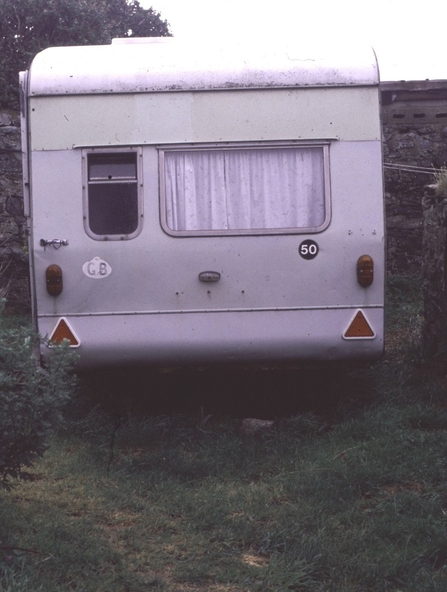
The small caravan used by the first Cemlyn wardens. Credit Jane Rees
The previous blog told the story of the reconstruction of the weir in 1977-78. When all the bills had been paid there was a small surplus, and it was decided to use the money to employ a reserve warden during the nesting season. We were given a small caravan which was almost hidden at the back of Plas Cemlyn’s farmyard. Michael Smith and his wife Florence cleaned it thoroughly. An Elsan was provided in an unused pig-sty, and we were all ready for our first warden, Tom Gravett, to move in. In the early days, prospective wardens were taken up to Cemlyn to see the reserve and to see how they reacted to the relatively primitive accommodation! Tom recently recalled his first sight of the small caravan but his abiding memory of the reserve is the noise – and in those days it was just the calls of common and Arctic terns. Later this caravan was replaced by a larger one courtesy of one of the local caravan parks.
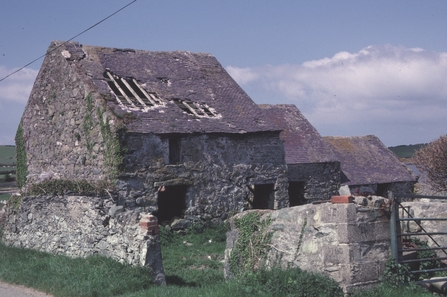
Hen Blas, Cemlyn prior to restoration in 1991 by the NT. Credit Jane Rees
In 1988 the derelict cottage across the road from Plas Cemlyn – used to house cattle – was no longer needed. It has a magnificent, huge, fireplace with a tapering stone chimney and is thought to date back to the 16th century. It also had a blocked-up window overlooking the pool and tern colony, ideal for warden’s accommodation! NT commissioned an architect to come up with a renovation plan and the work was completed in 1992. Hen Blas Cemlyn occupied by Cemlyn warden (and NT staff) in 1993. The building also provides an office and kitchen/meeting room for NT staff. There is a shower and toilet in the adjacent former goose house!
Next time we come right up to date and look at some of the wardens and other volunteers.
Find out how you can support our work to protect Cemlyn, its wonderful wildlife and inspire the next generation of conservationists on our Support Us pages.


